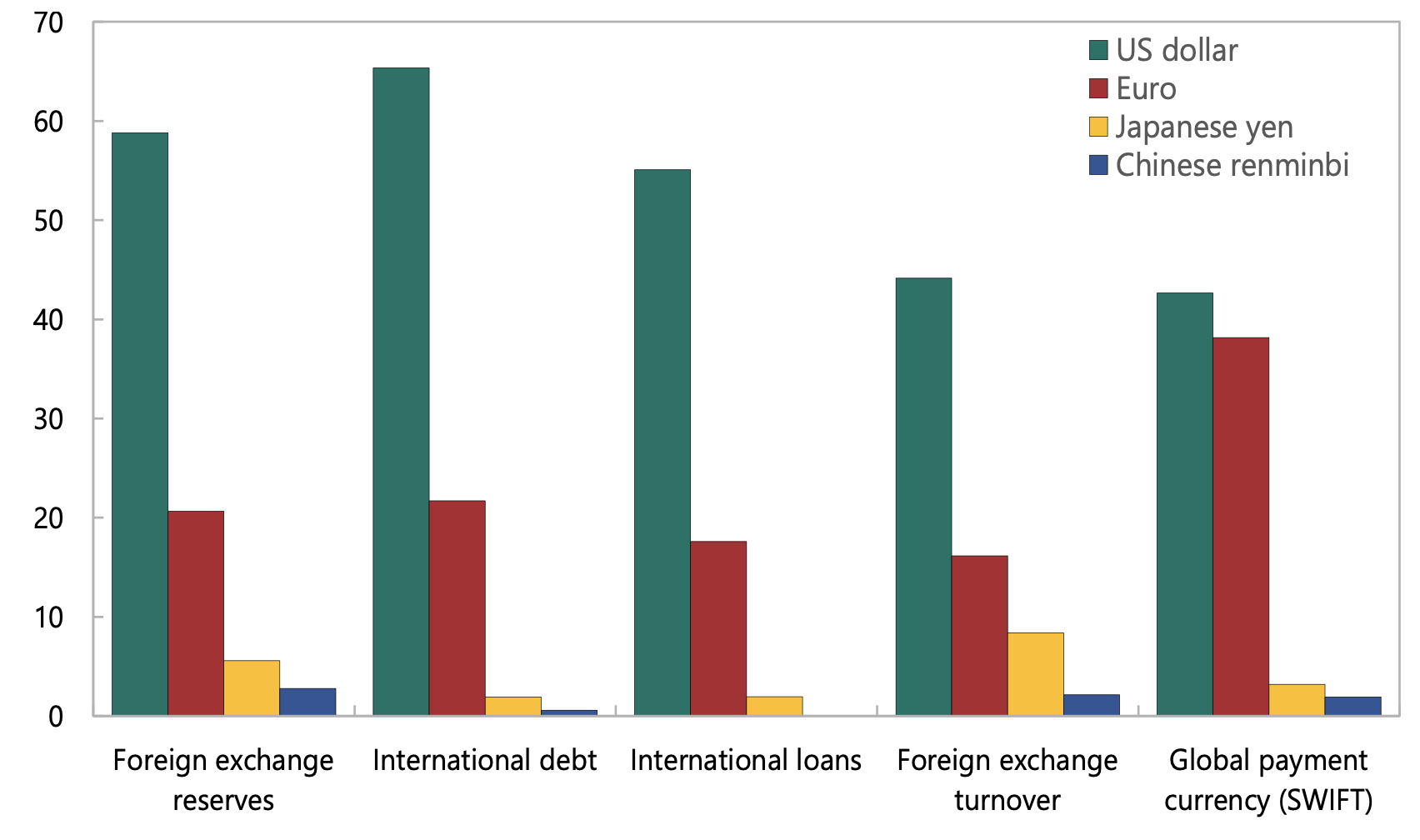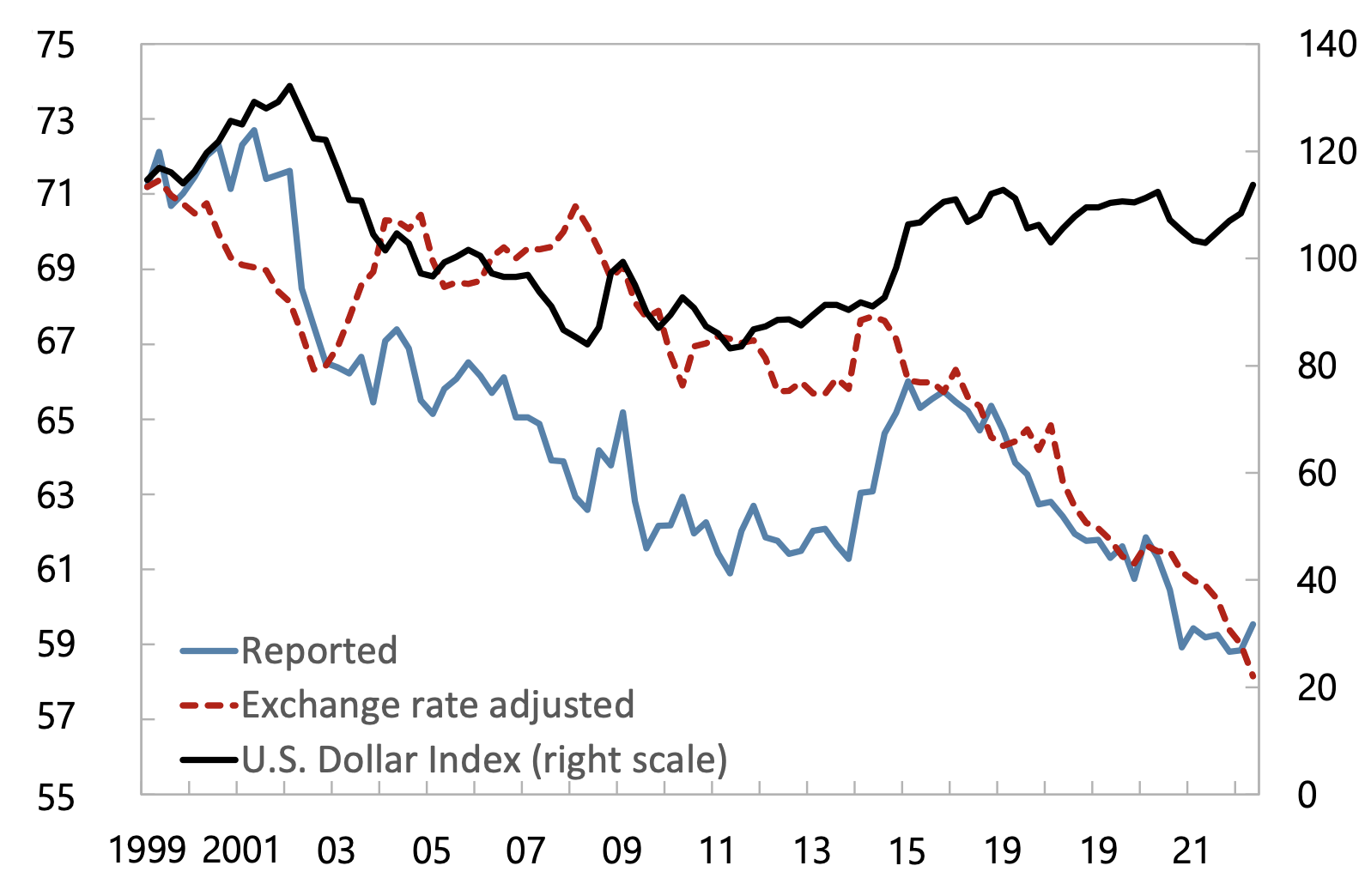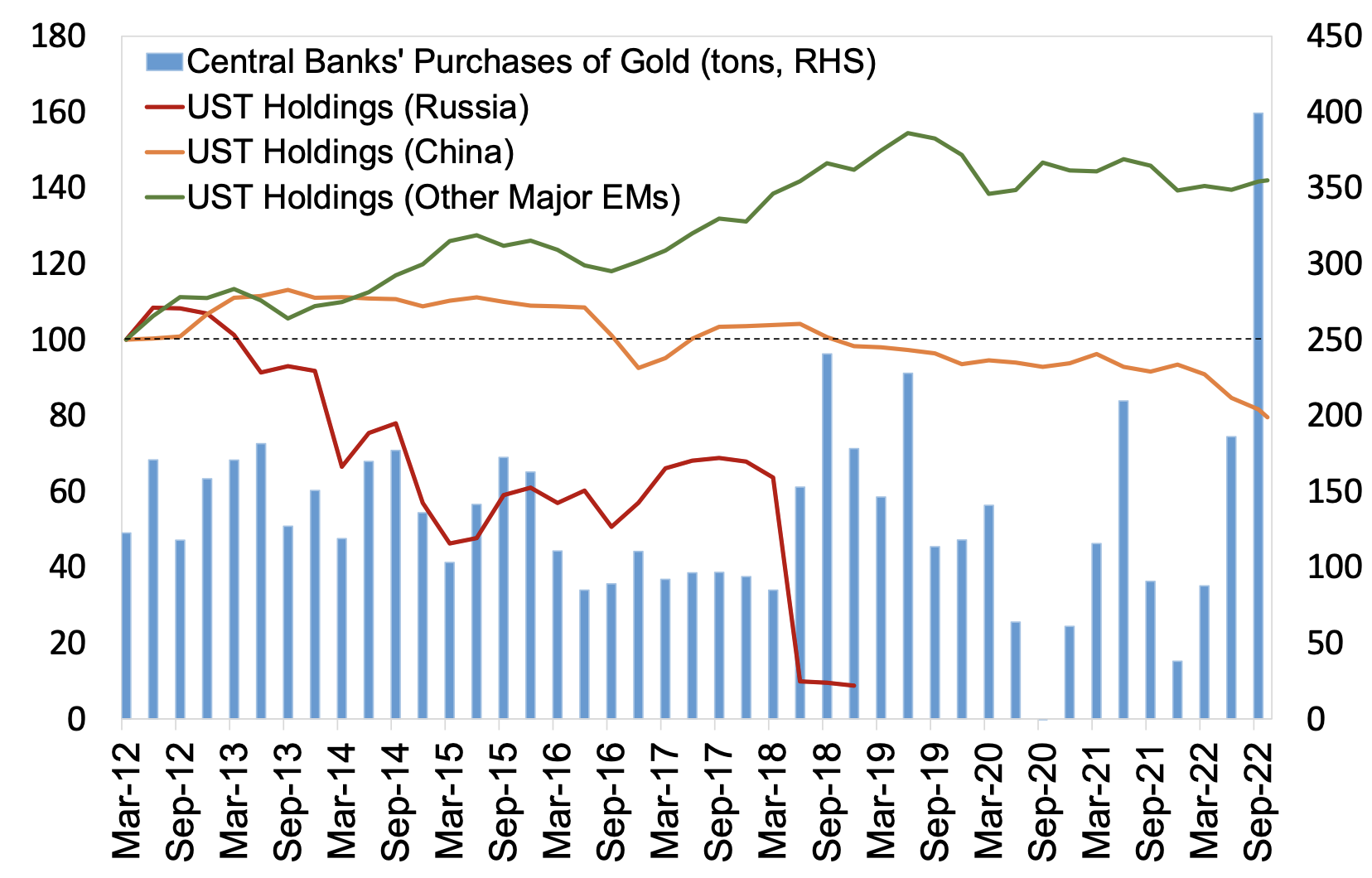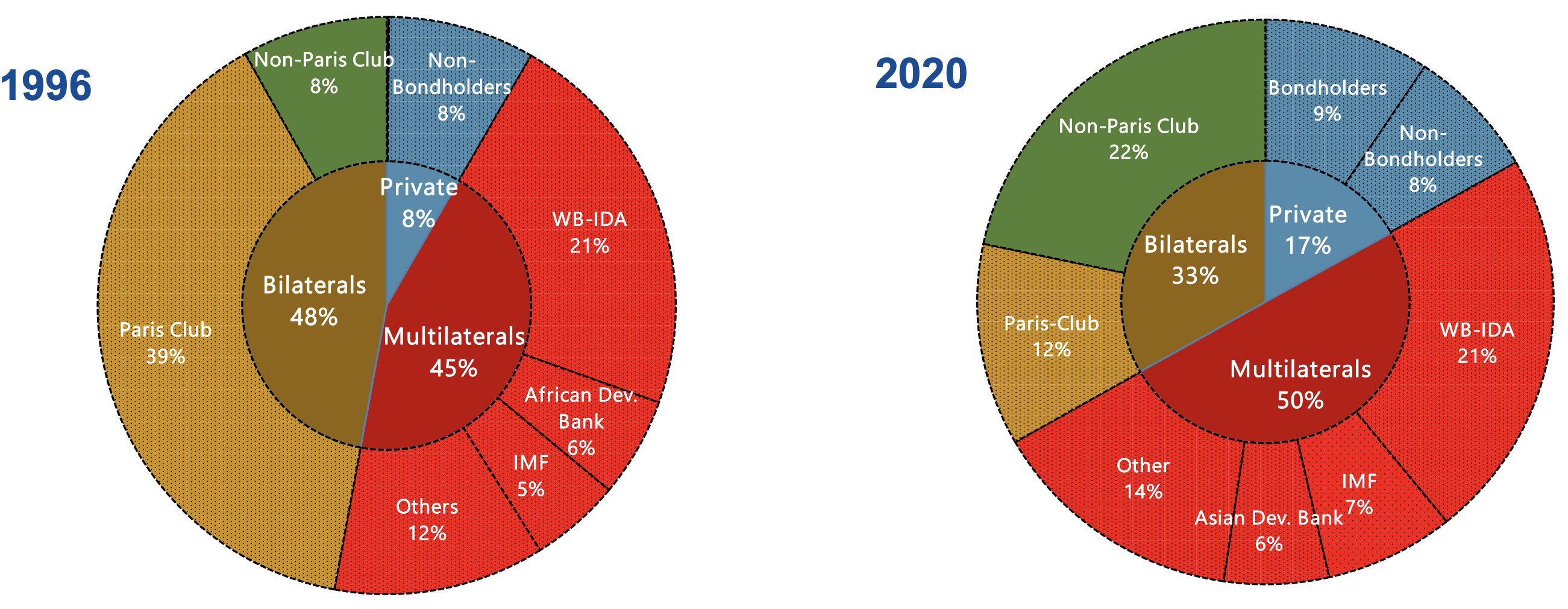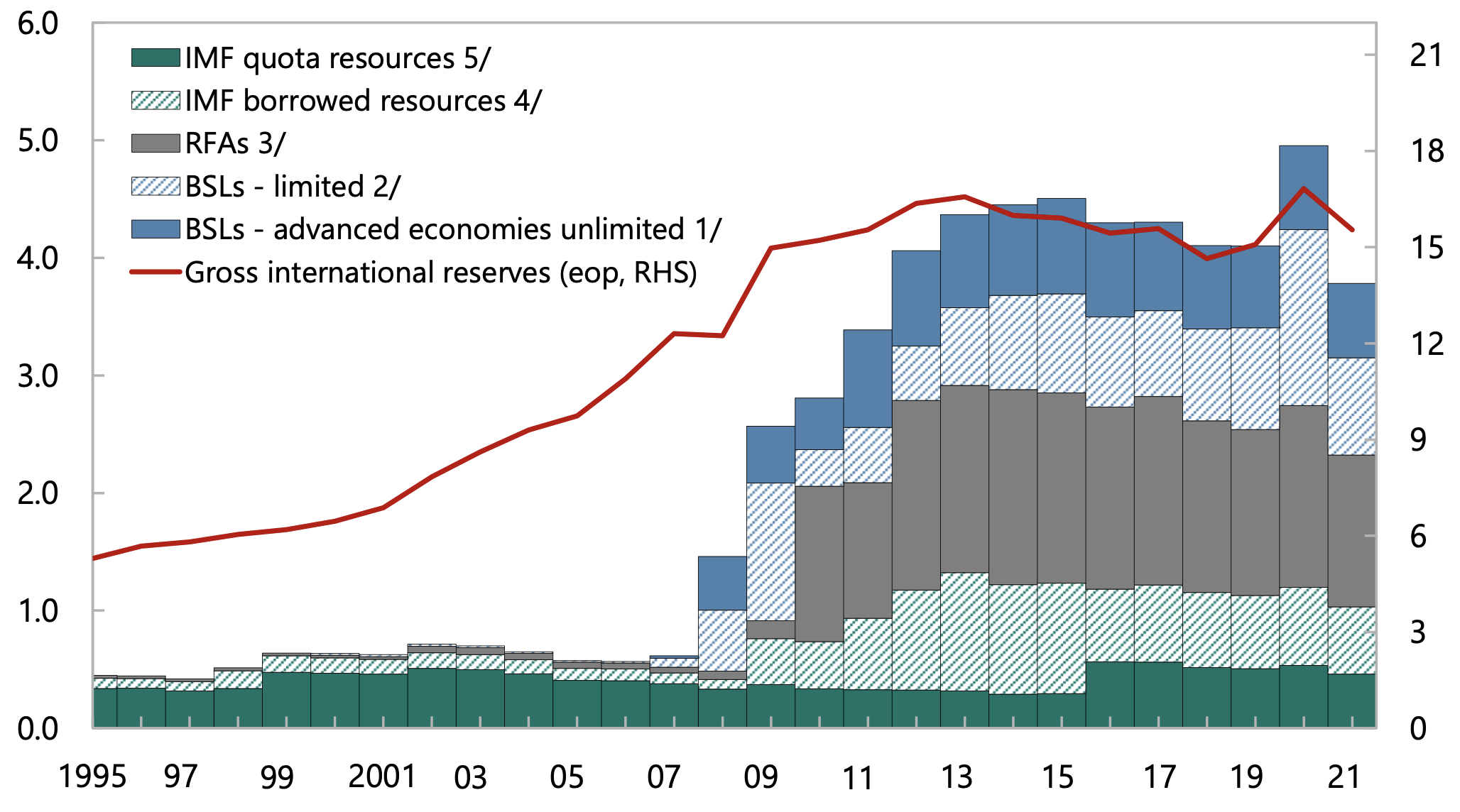The international monetary system comprises rules and conventions, mechanisms and institutions that facilitate international trade and cross-border investment (IMF 2011, 2016a). A robust international monetary system includes the following elements:
- An efficient and reliable international payment system (‘plumbing’) that provides certainty, safety, and efficiency in conducting transactions.
- A stable global reserve currency configuration that provides an effective means of exchange and liquid assets that can serve as a store of value.
- Robust mechanisms for crisis mitigation and resolution that can facilitate countries’ external adjustment after shocks and mitigate cross-border spillovers.
- And a robust global financial safety net (GFSN) that provides countries with insurance against shocks and mitigates systemic spillovers.
History shows that an international monetary system designed for a particular configuration of the world economy can become fragile in the face of large structural shifts. A notable example is the collapse of the Bretton Woods System in the 1970s, when growing economic tensions forced the US to abandon dollar–gold convertibility. Aiyar et al. (2023) discuss some of the potential implications of the growing geo-economic fragmentation risks for the international monetary system.
The international payment system
The international payment system is at risk of becoming more fragmented. After Russia’s invasion of Ukraine in February 2022, key Russian banks were banned from using SWIFT, thus limiting their ability to make transactions with the rest of the world.
If geo-economic fragmentation continues to unfold, other countries may seek to become less reliant on the international financial infrastructure and standards. This could be driven by the fear of sanctions, or a partial redenomination of trade and financial operations into other currencies, or other geopolitical considerations. As a result, parallel new systems that lack inter-operability may emerge, leading to higher transaction costs and other inefficiencies. A more fragmented global payment system could in turn reinforce fragmentation in trade and capital flows.
Geo-economic fragmentation could also limit gains from digitalisation. New forms of both central bank and privately issued digital money have the potential to significantly improve payment efficiency domestically and across borders (BIS 2022). However, the widespread adoption of digital currencies in the context of geo-economic fragmentation raises the risk of fragmentation in regulation and supervision (IMF 2021), which may compromise the orderly transition to a modernised digital international monetary system.
Global reserve currency configuration
Currently, the US dollar is the dominant currency for most cross-border transactions and US dollar sovereign bonds are the most widely held safe assets globally (Figure 1). If geo-economic fragmentation continues unabated, the global currency configuration may have to adjust to reflect new economic realities. The transition may be bumpy.
Figure 1 Role of major currencies in the international monetary system
Sources: Bank for International Settlements; IMF; Society for Worldwide Interbank Financial Telecommunication (SWIFT); and ECB calculations.
Note: The latest data for foreign exchange reserves, international debt and international loans are for the fourth quarter of 2021. Foreign exchange turnover data as of April 2019. SWIFT data as of December 2021.
Geo-economic fragmentation could also lead to shifts in preferences over the currency composition of FX reserves:
- First, countries are now more sensitised to the risk of financial sanctions. The freezing by the US and its allies of about $300 billion of the Russian central bank’s FX reserves following the invasion of Ukraine will likely influence the reserve management decisions of countries that do not have friendly relations with the US and Europe (Mühleisen 2022).
- Second, both sanctions as well as broader national security (or economic security) considerations may drive a reshaping of trade and global value chains through ‘reshoring’ or ‘friendshoring’. This may lead to less trade invoicing in US dollars and a greater use of other currencies in cross-border transactions.
Historically, changes in reserve currency configurations have been slow (Figure 2), reflecting inertia and a lack of viable alternatives to dominant currencies (in terms of economic size, policy credibility, transactional demand, and network effects). While a widespread adoption of digital currencies may accelerate FX reserve diversification, changes in the reserve composition may be initially limited and tilted towards gold – a ‘politically neutral’ reserve asset. Arslanalp et al. (2023) show that the imposition of financial sanctions by the main reserve-issuing countries is typically associated with an increase in the share of central bank reserves held in gold. In fact, they show that all active diversifiers into gold are emerging markets (EMs). While it is too early to call it a trend, central bank purchases of gold surged in Q3:2022, while some EM central banks have scaled back their US Treasury holdings (Figure 3).
Figure 2 US dollar share of global foreign exchange reserves and the US dollar index, 1999–2022:Q2 (percent; index Jan 2006 = 100)
Sources: Arslanalp et al. (2022); IMF, Currency Composition of Official Reserves (COFER); US Federal Reserve Board; and IMF staff estimates.
Figure 3 Central banks’ demand for gold and foreign holdings of US Treasury securities (percent, index Mar 2012 = 100, tons)
Sources: Treasury International Capital data; and World Gold Council.
Note: “Other major EMs” include countries with data consistently available for all years 2012–22 (Brazil, Chile, China, Colombia, India, Iraq, Kuwait, Mexico, Peru, Philippines, Saudi Arabia, Thailand, UAE).
Crisis mitigation and resolution
Geo-economic fragmentation could also induce a shift from financial globalisation to ‘financial regionalisation’, which could weaken international risk-sharing and lead to greater macroeconomic volatility at the country level. International policy coordination and global liquidity provision may be hampered as well. In the absence of international policy coordination, countries would have to rely on bloc-specific adjustment mechanisms and costly self-insurance (such as reduced reliance on external debt and higher FX reserves). As a result, crises could become more severe.
At the same time, crisis resolution could become more complicated. Since the 1990s, the foreign creditor base for low-income countries (LICs) has become more diverse: the share of Paris Club official creditors has declined, while the share of China, India, and other non-Paris Club official creditors has increased (Figure 4). If the world were to divide along geopolitical lines, debt resolution could become even more difficult, especially in LICs.
Figure 4 Creditor base for the PRGT-eligible countries, 1996 versus 2020 (percent of total external debt)
Sources: World Bank, International Debt Statistics; and IMF staff calculations.
Note: PRGT-eligible countries include countries that are eligible for concessional financing, see here.
The global financial safety net
The global financial safety net (GFSN) is a set of instruments and institutions that can provide countries with insurance against shocks, financing to mitigate the impact of shocks, and incentives for sound macro-economic policies (IMF 2016b). The current GFSN has four layers: central banks’ FX reserves, bilateral swap lines (BSLs), regional financing arrangements (RFAs), and the IMF (Figure 5). The IMF is the only GFSN layer that has global coverage. While demand for GFSN resources surged during the COVID-19 pandemic, the GFSN has been able to provide support partly due to its significant expansion after the Global Financial Crisis (Figure 5).
Figure 5 Evolution of the global financial safety net,1995–2021 (percent of global GDP)
Sources: Central cank websites; Regional Financing Arrangements annual reports; and IMF staff estimates.
Note: Two-way arrangements are counted only once.
1 Permanent swap lines among major advanced economy central banks (Federal Rserve Board, European Central Bank, Bank of England, Bank of Japan, Swiss National Bank, Bank of Canada). The estimated amount is based on known past usage or, if undrawn, on average past maximum drawings of the remaining central bank members in the network, following the methodology in Denbee and others (2016).
2 Limited-amount swap lines include all arrangements with an explicit amount limit and exclude all CMIM arrangements, which are included under Regional Financing Arrangements.
3 Based on explicit lending capacity/limit where available, committed resources, or estimated lending capacity based on country access limits and paid-in capital.
4 After prudential balances.
5 Quota for countries in the Financial Transaction Plan after deducting prudential balance..
Geo-economic fragmentation could affect both the supply and demand for GFSN resources:
- On the supply side, Geo-economic fragmentation could lead to a reconfiguration of BSLs and RFAs along geopolitical lines, which (at least during transition) could disrupt liquidity provision. The bloc-specific importance of BSLs and RFAs will likely increase, but their coverage and governance could become more uneven and less coordinated with the rest of the GFSN. As a result, the GFSN could become more fragmented and under-resourced.
- On the demand side, geo-economic fragmentation could induce a reconfiguration of trade and financial links, a process that would likely be accompanied by more volatile capital flows, bank disintermediation, a greater incidence of currency substitution, and more severe crises. Bloc-specific arrangements could, in principle, provide some safety net but may be insufficient against large shocks. Thus, geo-economic fragmentation would likely increase demand for GFSN resources.
In a more fragmentated world, the ability of multilateral institutions to mediate across blocs, to facilitate policy coordination and to ensure adequacy of the GFSN will be critical. But to fulfill this role, multilateral institutions will have to remain representative of their global membership and be perceived as impartial and even-handed, which may be challenging in today’s geopolitically charged world.
References
Aiyar, S, J Chen, C Ebeke, R Garcia-Saltos, T Gudmundsson, A Ilyina, A Kangur, S Rodriguez, M Ruta, T Schulze, J Trevino, T Kunaratskul and G Soderberg (2023), “Geoeconomic Fragmentation and the Future of Multilateralism”, IMF Staff Discussion Note No. SDN/2023/01.
Arslanalp, S, B Eichengreen and C Simpson-Bell (2022), “The Stealth Erosion of Dollar Dominance and the Rise of Nontraditional Reserve Currencies”, Journal of International Economics 138: 103655.
Arslanalp, S, B Eichengreen and C Simpson-Bell (2023), “Gold as International Reserves: A Barbarous Relic No More?” IMF Working Paper No. WP23/14.
BIS – Bank for International Settlements (2022), Options for Access to and Interoperability of CBDCs for Cross-Border Payments. Report to the G20, Bank for International Settlements, IMF and World Bank
IMF – International Monetary Fund (2011), “Strengthening the International Monetary System: Taking Stock and Looking Ahead”, IMF Policy Paper.
IMF (2016a), “Strengthening the International Monetary System: A Stocktaking”, IMF Policy Paper.
IMF (2016b), “Adequacy of the Global Financial Safety Net”, IMF Policy Paper.
IMF (2021), “The Rise of Public and Private Digital Money – A Strategy to Continue to Deliver on the IMF’s Mandate”, IMF Policy Paper No. 2021/055.
Mühleisen, M (2022), “The International Role of the Euro and the Dollar”, The Atlantic Council.

